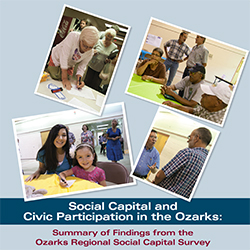By Mark D. Potter

Healthy Communities, Healthy Colleges: Advancing Civic Health with Data and Action Opening Essay: March 2016 Special Issue, eJournal of Public Affairs Mark D. Potter Metropolitan State University of Denver Increasingly, measurement matters. The capabilities and applications of “big data” are expanding to shape strategies and practices in such disparate areas as product development, marketing, sports analysis, public health, and political prognosis (Cukier & Mayer-Schoenberger, 2013). Data science is growing as a discipline, with institutions such as the University of California at Berkeley and Rutgers University offering Master’s programs in the field. Change initiatives and collective-impact frameworks rely on data, while funders insist more and more on accountability through reliable measurements (Kania & Kramer, 2011). Higher education, too, is being asked to account for its impact by embracing return-oninvestment analyses, economic-impact analyses, outcomes surveys, and learning assessment. Across multiple sectors, data and action increasingly accompany and inform each other. In the midst of these trends, the National Conference on Citizenship (NCoC) launched a systematic approach to measuring civic health with the publication in 2006 of America’s Civic Health Index. Since its founding 70 years ago, NCoC’s purpose has been to advance civic life in America. In their efforts to fulfill this mission, NCoC leaders determined that if in fact they were to effectively improve civic life, they needed a means of measuring civic health (S. Prouty, personal communication, March 1, 2016). Thus, beginning in 2008, NCoC partnered with state and local communities to publish civic health indexes (CHIs), which report multiple measures of civic health compiled from Current Population Survey (CPS) data. Annual supplements to the CPS capture volunteering and charitable-giving estimates, voting and registration numbers, and a range of additional civic engagement indicators such as contacting local officials, discussing politics, participating in boycotts, and trusting people in the neighborhood. Together, these measures capture a community’s civic connectedness and political engagement, and today 27 states and nine cities have partnered with NCoC to produce CHIs. Civic health indexes allow communities to identify areas of strength and weakness and then act accordingly to strengthen civic connectedness and engagement. For example, the Center for the Future of Arizona has woven the findings of the Arizona CHI into a broader initiative to engage the state’s population around the “Arizona We Want,” an initiative that has activated a network of organizations focused on moving Arizona into the top 10 state rankings on each civic health measure (Center for the Future of Arizona, 2015). This interplay of data and action also aligns with emerging priorities in higher education. Student retention efforts have become increasingly data-driven. College and university teams are using action research to shape inquiry into issues of institutional effectiveness and equity (Dowd, Sawatzky, Rall, & Bensimon, 2012). Similarly, in their outreach and community engagement, colleges and universities are using assessment to help sustain reciprocal and mutually beneficial partnerships (Gelmon, Holland, Driscoll, Spring, & Kerrigan, 2006). The expectation that institutions will embed assessment into community engagement is reinforced in the documentation framework for the elective Carnegie Foundation Community Engagement Classification. Community engagement is, of course, featured commonly in the missions of U.S. colleges and universities. The Carnegie Foundation currently counts 361 colleges and universities among those institutions that currently hold its elective Community Engagement Classification (New England Resource Center, n.d.). Land grant universities place outreach at the core of their historically determined missions, and the American Association of State Colleges and Universities (AASCU) encourages its member institutions to consider themselves as stewa health on campus, in the community, or where the two intersect, colleges and universities participating in this initiative positioned themselves for data-driven action to engage with community partners for the strengthening of civic connectedness and political engagement. Twenty-five colleges and universities participated in the Campus & Community Civic Health initiative, which was launched in 2012, with NCoC as a convening partner. Participating campuses committed to devising measures and metrics for assessing civic health and then to acting on their findings. As the examples in this issue illustrate, approaches and outcomes of the initiative varied. Some institutions partnered with NCoC to produce a CHI for their respective state or community. A recent study found that such partnerships align strongly with faculty’s scholarly and teaching interests as well as institutions’ community engagement missions (Coates, Potter, & Weiker, 2015). Other participants in the Campus & Community Civic Health initiative took the approach of developing their own measures to understand levels of campus engagement or connectedness in the community. Many campuses found that whatever their approach to measuring civic health, the very act of doing so catalyzed engagement and helped to strengthen partnerships in the community and across the state. In this issue, Ashley Trim argues that universities are uniquely positioned to help improve civic connectedness and political engagement. At Pepperdine University, the Davenport Institute for Public Engagement and Civic Leadership followed up on its involvement in releasing the 2010 California CHI with programs aimed at supporting and training local government leaders in public engagement skills. Although Pepperdine University was not a participant in the Campus & Community Civic Health initiative, Trim’s article demonstrates how data—in this case data presented in a CHI—can inform and advance the civic engagement mission of a university. Like Trim, Ellen Szarleta focuses her analysis on local and state partnerships, though in this case with Indiana University Northwest at the center of a network in which dialogue and deliberation are the methods used to engage regional public, private, and non-profit leaders. These efforts benefited not only from two state CHIs, in 2011 and 2015, but from top-level university leaders who created the Chancellor’s Commission for Community Engagement. The regional leaders who have participated in the Chancellor’s Commission commit to a process of public deliberation, and they benefit by hearing multiple perspectives in a setting constructed more for “weighing” than for “winning.” Van Liere, Arney, and Arney report on findings from the University of Wisconsin-La Crosse, where a student research project measured campus civic health. Students in a political science and public administration capstone course tailored NCoC indicators to conduct interviews with student organizations, campus offices, and university faculty. They found that their methodology uncovered actualizing engagement practices, such as volunteering and engaging in consumer activism, far more than what the commonly used National Survey of Student Engagement (NSSE) captures. This article acts as an important reminder of the need to regularly revisit collective understanding of civic health and civic engagement and ensure that methods of gathering data on student civic engagement are keeping pace with shifts in how students engage. The Reports and Instruments section that closes this issue presents a sample of artifacts from the Campus & Community Civic Health initiative. At SUNY Brockport, students in an introductory political science research-methods course, under the supervision of Susan Orr and Dena Levy, undertook a mini civic health survey of the campus using the same metrics as those featured in CHIs. Students in an advanced research-methods course at Metropolitan State University of Denver wrote and administered a survey to businesses in a neighborhood adjacent to campus in an attempt to measure social trust and connectedness. Lastly, a Missouri State University study that explored the relationship between social capital and civic participation, and that was begun prior to the launch of the Campus & Community Civic Health initiative, demonstrates how deeply engrained civic health work is in the missions and activities at some universities. By all indications, close alignment and strong partnerships will persist between higher education and NCoC for the purpose of advancing civic health. From the perspective of NCoC, colleges and universities are natural partners that share a common commitment (S. Prouty, personal communication, March 1, 2016). Colleges and universities that have already partnered with NCoC on the production of CHIs have found that work beneficial to advancing the institutions’ missions. Faculty members and university administrators have indicated that the benefits of the partnership have accrued to teaching (“I use the CHI as a teaching tool in class”), community partnerships (“We have used the CHI to build bridges to K-12 educators throughout the region”), and community-based research (“We shared the report in a number of public forums with leaders from all sectors in the state, and we supplemented the… data… provided by NCoC with data from local partners to provide a richer picture of our state”) (Coates et al., 2015). The Campus & Community Civic Health initiative of the ADP leveraged these areas of mutual benefit to great effect. This collection of articles and artifacts will ideally maintain the progress and the commitment to strengthening the civic fabric of American society.



